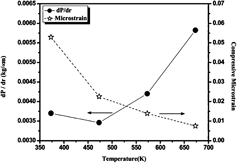Crossref Citations
This article has been cited by the following publications. This list is generated based on data provided by
Crossref.
Kiahosseini, Seyed Rahim
Afshar, Abdollah
Larijani, Majid Mojtahedzadeh
and
Yousefpour, Mardali
2014.
Adhesion, micro- strain and corrosion behavior of ZrN coated AZ91 alloy as a function of temperature.– CORRIGENDUM.
Journal of Materials Research,
Vol. 29,
Issue. 5,
p.
729.
Mola, Renata
2015.
The properties of Mg protected by Al- and Al/Zn-enriched layers containing intermetallic phases.
Journal of Materials Research,
Vol. 30,
Issue. 23,
p.
3682.
Shirazi, Amir Khodaparast
and
Kiahosseini, Seyed Rahim
2017.
Hot corrosion of the ceramic composite coating Ni3Al–Al2O3–Al2O3/MgO plasma sprayed on 316L stainless steel.
International Journal of Materials Research,
Vol. 108,
Issue. 8,
p.
675.
Kiahosseini, Seyed Rahim
and
Mojtahedzadeh Larijani, Majid
2017.
Effects of nitrogen gas ratio on the structural and corrosion properties of ZrN thin films grown on biodegradable magnesium alloy by ion-beam sputtering.
Applied Physics A,
Vol. 123,
Issue. 12,
Kiahosseini, Seyed Rahim
Afshar, Abdollah
Mojtahedzadeh Larijani, Majid
and
Yousefpour, Mardali
2017.
Structural and corrosion characterization of hydroxyapatite/zirconium nitride-coated AZ91 magnesium alloy by ion beam sputtering.
Applied Surface Science,
Vol. 401,
Issue. ,
p.
172.
Fooladi, Saeid
and
Kiahosseini, Seyed Rahim
2017.
Creation and investigation of chitin/HA double-layer coatings on AZ91 magnesium alloy by dipping method.
Journal of Materials Research,
Vol. 32,
Issue. 13,
p.
2532.
Chinizadeh, Morteza
and
Kiahosseini, Seyed Rahim
2017.
Deformation, microstructure, hardness, and pitting corrosion of 316 stainless steel after laser forming: A comparison between natural and forced cooling.
Journal of Materials Research,
Vol. 32,
Issue. 16,
p.
3046.
Kiahosseini, Seyed Rahim
Mohammadi Baygi, Seyyed Javad
Khalaj, Gholamreza
Khoshakhlagh, Ali
and
Samadipour, Razieh
2018.
A Study on Structural, Corrosion, and Sensitization Behavior of Ultrafine and Coarse Grain 316 Stainless Steel Processed by Multiaxial Forging and Heat Treatment.
Journal of Materials Engineering and Performance,
Vol. 27,
Issue. 1,
p.
271.
Vasylyev, M.A.
Mordyuk, B.N.
Sidorenko, S.I.
Voloshko, S.M.
Burmak, A.P.
Kruhlov, I.O.
and
Zakiev, V.I.
2019.
Characterization of ZrN coating low-temperature deposited on the preliminary Ar+ ions treated 2024 Al-alloy.
Surface and Coatings Technology,
Vol. 361,
Issue. ,
p.
413.
Manafi, Sahebali A.
Joughehdoust, S.
Kiahosseini, S. R.
and
Farahbakhsh, I.
2019.
Optimization of mechanical alloying parameters for synthesis of nanostructure hexagonal BaFe12O19.
Journal of the Australian Ceramic Society,
Vol. 55,
Issue. 2,
p.
371.
Kiahosseini, Seyed Rahim
and
Aminian, Armin
2019.
Mechanical and corrosion performance of multilayer ceramic coatings deposited on an austenitic stainless steel using plasma spray.
Bulletin of Materials Science,
Vol. 42,
Issue. 4,
S. Vanegas, Henry
E. Alfonso, Jose
and
J. Olaya, Jhon
2019.
Silicon Materials.
Kiahosseini, Seyed Rahim
and
Ahmadian, Hossein
2020.
Effect of residual structural strain caused by the addition of Co3O4 nanoparticles on the structural, hardness and magnetic properties of an Al/Co3O4 nanocomposite produced by powder metallurgy.
International Journal of Minerals, Metallurgy and Materials,
Vol. 27,
Issue. 3,
p.
384.
Gupta, Jhalak
and
Ahmed, Arham S.
2020.
Interfacial exchange coupling and defects driven magnetic and optical properties of Co3O4-NiO nanocomposites.
Physica B: Condensed Matter,
Vol. 599,
Issue. ,
p.
412383.
Cui, Pengxing
Hu, Maoliang
Ji, Zesheng
Xu, Hongyu
Liu, Naizhi
and
Yan, Zhehua
2023.
Effect of La/Nd Ratio on the Microstructure and Corrosion Behaviors of Squeeze-Cast Mg–Al–Zn–La–Nd Alloys.
International Journal of Metalcasting,
Vol. 17,
Issue. 1,
p.
248.
Gupta, Jhalak
Ahmed, Arham S.
Anwer, Abdul Hakeem
Benamor, Abdelbaki
Khan, Mohammad Zain
and
Azam, Ameer
2024.
GO optimization strategies for improved capacity retention in transition metal oxides based ternary nanocomposites for high-performance supercapacitors.
Materials Today Communications,
Vol. 39,
Issue. ,
p.
108683.
Protsak, Mariia
Biliak, Kateryna
Nikitin, Daniil
Pleskunov, Pavel
Tosca, Marco
Ali-Ogly, Suren
Hanuš, Jan
Hanyková, Lenka
Červenková, Veronika
Sergievskaya, Anastasiya
Konstantinidis, Stephanos
Cornil, David
Cornil, Jérôme
Cieslar, Miroslav
Košutová, Tereza
Popelář, Tomáš
Ondič, Lukáš
and
Choukourov, Andrei
2024.
One-step synthesis of photoluminescent nanofluids by direct loading of reactively sputtered cubic ZrN nanoparticles into organic liquids.
Nanoscale,
Vol. 16,
Issue. 5,
p.
2452.





